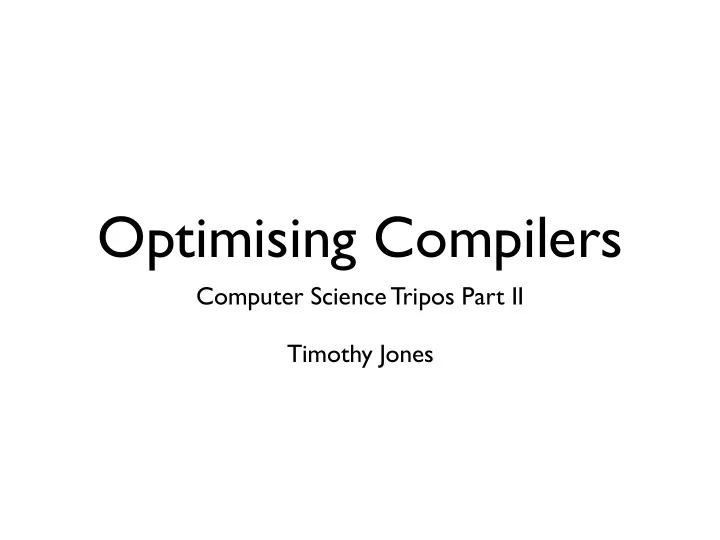

Optimising Compilers Computer Science Tripos Part II Timothy Jones
Lecture 1 Introduction
A non-optimising compiler character stream lexing token stream parsing parse tree translation intermediate code code generation target code
An optimising compiler character stream lexing token stream parsing optimisation parse tree translation optimisation decompilation intermediate code code generation optimisation target code
Optimisation (really “amelioration”!) Good humans write simple, maintainable, general code. Compilers should then remove unused generality , and hence hopefully make the code: • Smaller • Faster • Cheaper (e.g. lower power consumption)
Optimisation = Analysis + Transformation
Analysis + Transformation • Transformation does something dangerous . • Analysis determines whether it’s safe .
Analysis + Transformation • An analysis shows that your program has some property... • ...and the transformation is designed to be safe for all programs with that property... • ...so it’s safe to do the transformation.
Analysis + Transformation int main(void) { return 42; } int f(int x) { return x * 2; }
Analysis + Transformation int main(void) { return 42; } ✓ int f(int x) { return x * 2; }
Analysis + Transformation int main(void) { return f(21); } int f(int x) { return x * 2; }
Analysis + Transformation int main(void) { return f(21); } ✗ int f(int x) { return x * 2; }
Analysis + Transformation while (i <= k*2) { j = j * i; i = i + 1; }
Analysis + Transformation } ✓ int t = k * 2; while (i <= t) { j = j * i; i = i + 1;
Analysis + Transformation while (i <= k*2) { k = k - i; i = i + 1; }
Analysis + Transformation int t = k * 2; } ✗ while (i <= t) { k = k - i; i = i + 1;
Stack-oriented code iload 0 ireturn ? iload 1 iadd iload 2 iload 3 iadd imul
3-address code MOV t32,arg1 MOV t33,arg2 ADD t34,t32,t33 MOV t35,arg3 MOV t36,arg4 ADD t37,t35,t36 MUL res1,t34,t37 EXIT
C into 3-address code int fact (int n) { if (n == 0) { return 1; } else { return n * fact(n-1); } }
C into 3-address code ENTRY fact MOV t32,arg1 CMPEQ t32,#0,lab1 SUB arg1,t32,#1 CALL fact MUL res1,t32,res1 EXIT lab1: MOV res1,#1 EXIT
Flowgraphs • A graph representation of a program • Each node stores 3-address instruction(s) • Each edge represents (potential) control flow: { n � | ( n � , n ) ⇥ edges ( G ) } pred ( n ) = { n � | ( n, n � ) ⇥ edges ( G ) } succ ( n ) =
Flowgraphs ENTRY fact MOV t32,arg1 CMPEQ t32,#0 SUB arg1,t32,#1 MOV res1,#1 CALL fact MUL res1,t32,res1 EXIT EXIT
Basic blocks A maximal sequence of instructions n 1 , ..., n k which have • exactly one predecessor (except possibly for n 1 ) • exactly one successor (except possibly for n k )
Basic blocks ENTRY fact MOV t32,arg1 CMPEQ t32,#0 SUB arg1,t32,#1 MOV res1,#1 CALL fact MUL res1,t32,res1 EXIT EXIT
Basic blocks ENTRY fact MOV t32,arg1 CMPEQ t32,#0 SUB arg1,t32,#1 MOV res1,#1 CALL fact EXIT MUL res1,t32,res1 EXIT
Basic blocks ENTRY fact MOV t32,arg1 CMPEQ t32,#0 SUB arg1,t32,#1 MOV res1,#1 CALL fact MUL res1,t32,res1 EXIT
Basic blocks A basic block doesn’t contain any interesting control flow.
Basic blocks Reduce time and space requirements for analysis algorithms by calculating and storing data flow information once per block (and recomputing within a block if required) instead of once per instruction.
Basic blocks ? MOV t32,arg1 MOV t33,arg2 ADD t34,t32,t33 MOV t35,arg3 MOV t36,arg4 ADD t37,t35,t36 MUL res1,t34,t37
Basic blocks ? ? ? ? ?
Types of analysis (and hence optimisation) Scope: • Within basic blocks (“local” / “peephole”) • Between basic blocks (“global” / “intra-procedural”) • e.g. live variable analysis, available expressions • Whole program (“inter-procedural”) • e.g. unreachable-procedure elimination
Peephole optimisation replace ADD t32,arg1,#1 MOV x , y MOV r0,r1 matches MOV y , x MOV r1,r0 MUL t33,r0,t32 with MOV x , y ADD t32,arg1,#1 MOV r0,r1 MUL t33,r0,t32
Types of analysis (and hence optimisation) Type of information: • Control flow • Discovering control structure (basic blocks, loops, calls between procedures) • Data flow • Discovering data flow structure (variable uses, expression evaluation)
Finding basic blocks 1. Find all the instructions which are leaders : • the first instruction is a leader; • the target of any branch is a leader; and • any instruction immediately following a branch is a leader. 2. For each leader, its basic block consists of itself and all instructions up to the next leader.
Finding basic blocks ENTRY fact MOV t32,arg1 CMPEQ t32,#0,lab1 SUB arg1,t32,#1 CALL fact MUL res1,t32,res1 EXIT lab1: MOV res1,#1 EXIT
Summary • Structure of an optimising compiler • Why optimise? • Optimisation = Analysis + Transformation • 3-address code • Flowgraphs • Basic blocks • Types of analysis • Locating basic blocks
Recommend
More recommend